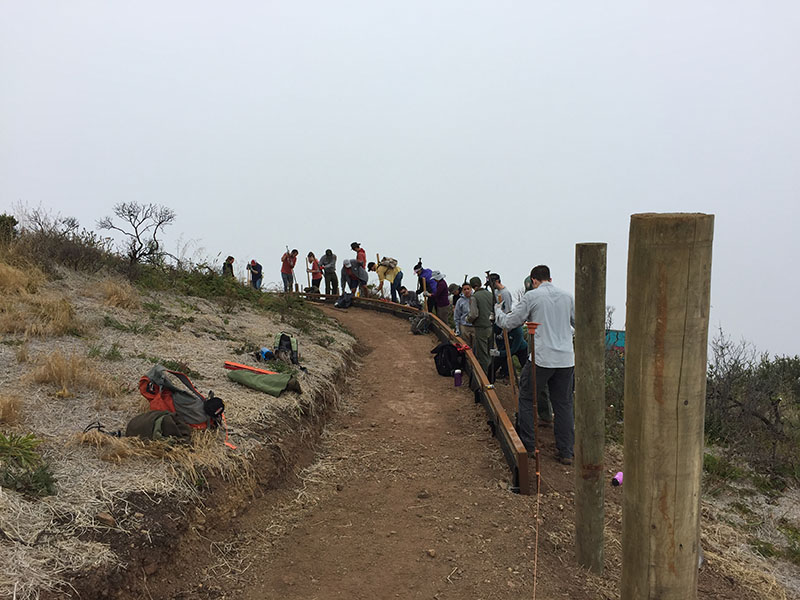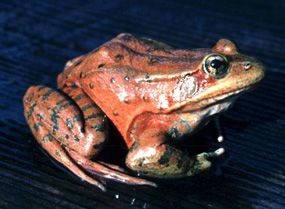|
Hello !
Autumn is officially here and we are totally in love. With warmer days and crisper nights, we can’t wait for the rest of Fall! We’ve got some special events coming up and are excited to see you at one of our programs.
We would like to send our heartfelt thoughts to all who have been affected by the wildfires in the North Bay. We wish you strength and comfort through this challenging time.
In This Issue
Park Spotlight: Hawk Hill
Last month: Coastal Cleanup Day
Endangered Species Spotlight
Park Spotlight: Hawk Hill
Beginning in March, the National Park Service Trail Crew, alongside our Parks Conservancy Intern Staff, have worked tirelessly on an ambitious trail realignment project at Hawk Hill. They have recently completed this project and the trail is now open to the public, while habitat restoration projects are still in progress. The crew worked to establish a safer, more accessible trail that now opens the trail to a broader range of park users, while protecting the surrounding sensitive habitat and cultural landmarks. The new trail follows the Draft Accessibility Guidelines for Outdoor Developed Areas and accommodates all hikers with a gentler slope to the summit. The project included the construction of new retaining walls to protect the adjacent habitat and protect against erosion, as well as improved handrails, staircases, and continued rehabilitation of disturbed areas of vegetation. This exciting new trail is part of an ongoing park effort to make our trails accessible to park users of all ages and ability levels.
Hawk Hill is featured prominently in the Marin Headlands and is one of the most scenic vistas in our park. Formerly a part of the US Army’s coastal defense system, Hawk Hill is now known as one of the premier locations for spotting migrating raptors along the coast. Hikers and bird watchers can see as many as 19 species of raptors, also known as birds of prey, especially in the fall season due to their migratory patterns. This is also an important ecological site in our park, providing the endangered mission blue butterfly with its habitat. The trail crew has worked with the habitat restoration team to protect the fragile habitat of this special endangered species in our park. The new trail limits the negative impact that hikers may have on this environment, while continuing to provide some of the best views in the Bay Area. Come out and enjoy a hike on this new trail, and don’t forget to bring your camera!

|
| Ky prepares for a foggy workday on Hawk Hill (Rudy Gastafson) |

|
| NPS Trail Crew and volunteers install post and cable fencing (Rudy Gastafson) |

|
| Kyle and Emilio survey the partially complete sutterwall. (Rudy Gastafson) |
Last Month: Coastal Cleanup Day
This past month, our volunteers participated in one of the biggest volunteer events of the year, California Coastal Cleanup Day. Statewide, more than 40,000 people volunteered to help turn back the tide of coastal debris and pick up trash to protect our fragile coastal ecosystem. Organized by the California Coastal Commission, this was the 33rd annual California Coastal Cleanup Day. 1,502 volunteers came out to help in the parks, and cleaned up a whopping 3,982 pounds of debris from our parklands, beaches, and bay!
Volunteers often find their fair share of bizarre items during coastal cleanup day, and this year was no different. Some of the more unusual items found this year include a corner of a $100 bill, a heart monitor, and even a message in a bottle! Trail Stewardship intern Helena Trifillis, excited about all of the good work our volunteers contributed, reported that, “Coastal Cleanup Day at Fort Funston was a blast! I found a pair of shoes, a deck of cards, and a bunch of nails just strewn about haphazardly across the beach. What a great day!”.
Coastal Cleanup Day is an incredibly important event in our park, and across the whole state. Trash, especially plastic fragments, have a way of working their way into our waterways and oceans via storm drains and run off. Much of this trash and the plastic in particular, never fully degrades and it ends up being consumed by wildlife and making its way up the food chain. This has compounding effects, and limiting our use of single-use plastic and preventing trash from entering waterways is the only way to improve the health of our marine ecosystems. The California Coastal Commission reported that over 75% of all trash collected on coastal cleanup day was plastic and particularly detrimental. Thank you so much to our volunteers, and keep up the good work keeping our beautiful coasts clean!

|
| The leaders of Coastal Clean Up Day at Fort Funston thank everyone who came out to volunteer! (Maria Durana) |
Endangered Species of the Month: California red-legged frog (Rana draytonii)
This month, we are going to take a look at one of the fascinating endangered species that can be found in our park, the California red-legged frog. This frog is one of the West’s largest frogs, growing up to 5 inches long, with a red abdomen and hind legs, and small black flecks and irregular dark blotches on it’s back. The population has dwindled due in large part to habitat loss. Historically, over 80,000 red-legged frogs were harvested annually by humans as well. Currently, only three locations are known to support substantial populations, according to Parks Conservancy research. While 70% of the red-legged frog’s habitat range has been eliminated, they are now mostly found in three California counties, Monterey, Santa Barbara and San Luis Obispo. Historically, their range extended to Marin County and Point Reyes National Seashore. Adult frogs thrive in dense, shrubby habitats, as well as areas of emergent riparian vegetation found near slow-moving or deep and still waters. In the winter, the frogs seek shelter in the well-vegetated areas alongside rivers and streams.
One of the primary challenges that the California red-legged frog faces today are an influx of predators in addition to their loss of habitat. Non-native bullfrogs and fish that prey on the frogs are two of the primary predators causing problems for our red-legged frogs. The Parks Conservancy, in a joint effort with the National Park Service and the US Fish & Wildlife Service, has been working to restore native habitats for the California red-legged frog and other endangered or threatened species in both San Mateo and Marin County. In our park, California red-legged frogs have been reintroduced at Mori Point in San Mateo as well as Muir Beach and Banducci in Marin County. Our park biologists work tirelessly to monitor and track populations and breeding patterns. These reintroduction projects have been successful, giving us hope for the future of the California red-legged frog!

|
| California red-legged frog |
Thanks for reading with us this month. We’d love to see all of your faces at one of our volunteer programs and events! See you soon!
All the very best and happy trails,
Katie, Jaclyn, and Patrick
kteschler@parksconservancy.org
|
ANNOUNCEMENTS
Next month: Bay Area Ridge Trail Day
Date: Saturday, November 4, 2017 9:00am-1:00pm
Location: Mill Valley - Dias Ridge, meet at Golden Gate Dairy
Please make sure to register using the link above
Teens on Trails is back for the school year!
Date: Saturday, October 28, 2017 10:00am-1:00pm
Location: Golden Gate Overlook, meet at Langdon Court
Register Here
Special Event: Women’s Trail Day!
Date: Saturday, December 2, 2017 10:00am-2:00pm
The lady trail builders of the National Park Service and Parks Conservancy are back at it again! We are pleased to announce our Second Women’s Trail Day in the GGNRA on Saturday December 2, 2017 from 10AM - 2PM. We are busy planning and getting ready for another empowering and inspiring, trail workin’, weed pullin’, gettin’ yer hands dirty, all women’s workday! Mark your calendars and stay tuned!
|